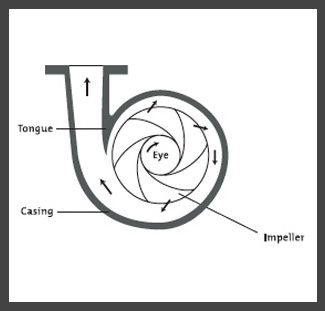Centrifugal pump
The essential components of a centrifugal pump are the fast-rotating impeller and the casing. Water flows into the centre “eye” of the impeller, where centrifugal force pushes the water outwards, to the casing. The kinetic energy of the water is partly converted to useful pressure that forces the water into the delivery pipe. Water leaving the central eye of the impeller creates a suction, which draws water from the source into the pump. An impeller and the matching section of the casing is called a “stage”.
Several stages can be combined with a single shaft to increase the overall pressure (multiple-stage pump). The water passes through the successive stages, with an increase in pressure at each stage. Multiple-stage centrifugal pumps are normally used when water has to be pumped to a significant height (200 m or more). For deep-well applications, the centrifugal pump and electrical engine are housed in a single unit. When the unit is to be located under the water level, a submersible pump will be required.
Suitable conditions
One limitation of a centrifugal pump is that the suction height cannot be higher than about 7 m above the water level. To overcome this limitation, and make it possible to place the pump above the suction limit, some pumps inject a jet stream of water into the suction pipe inlet. The kinetic energy of the injected water is partly converted into extra pressure, which helps to lift the water above the suction limit of the pump.

